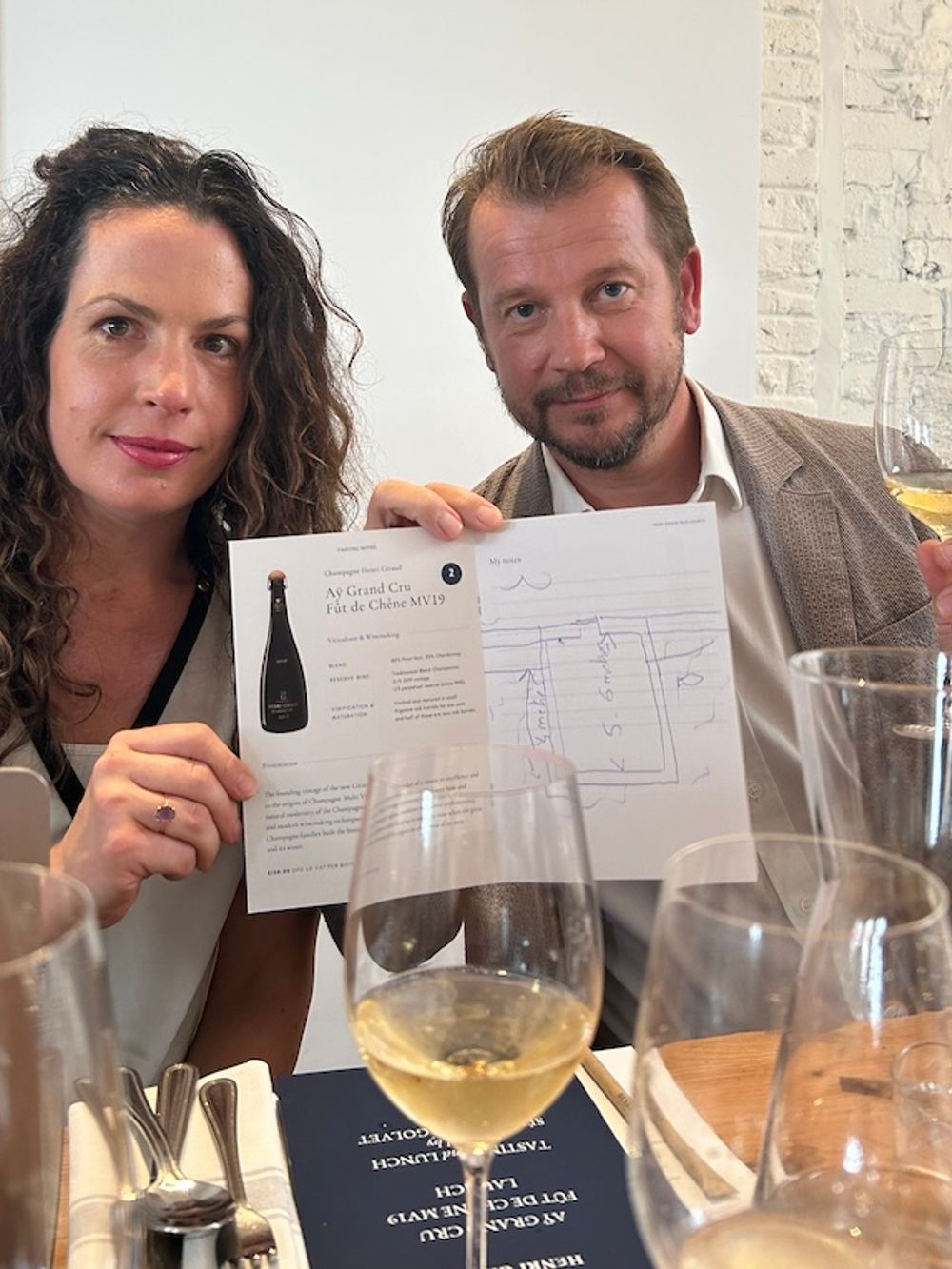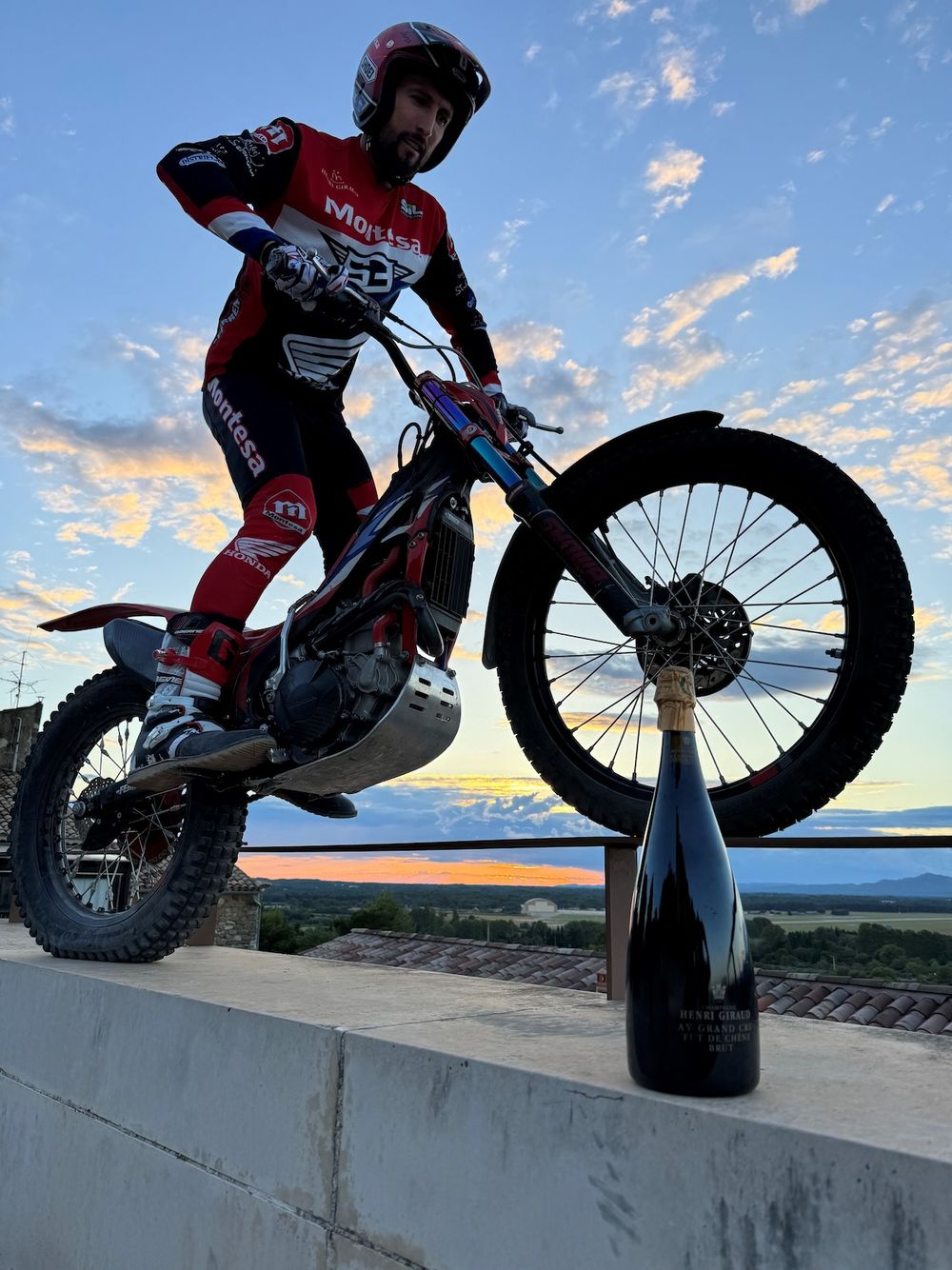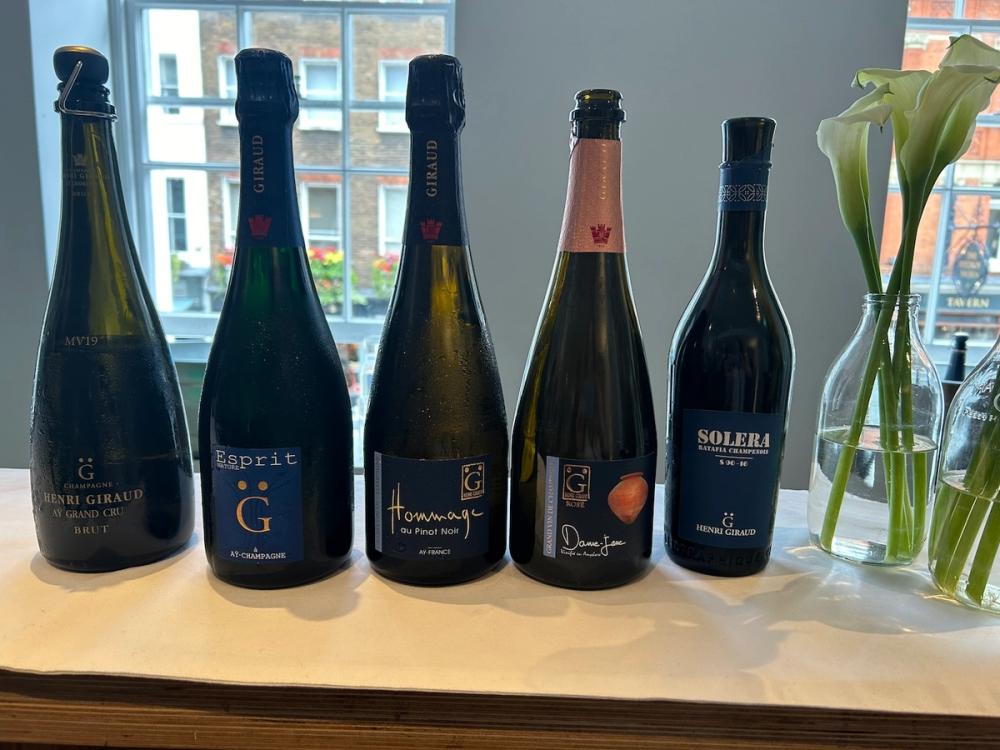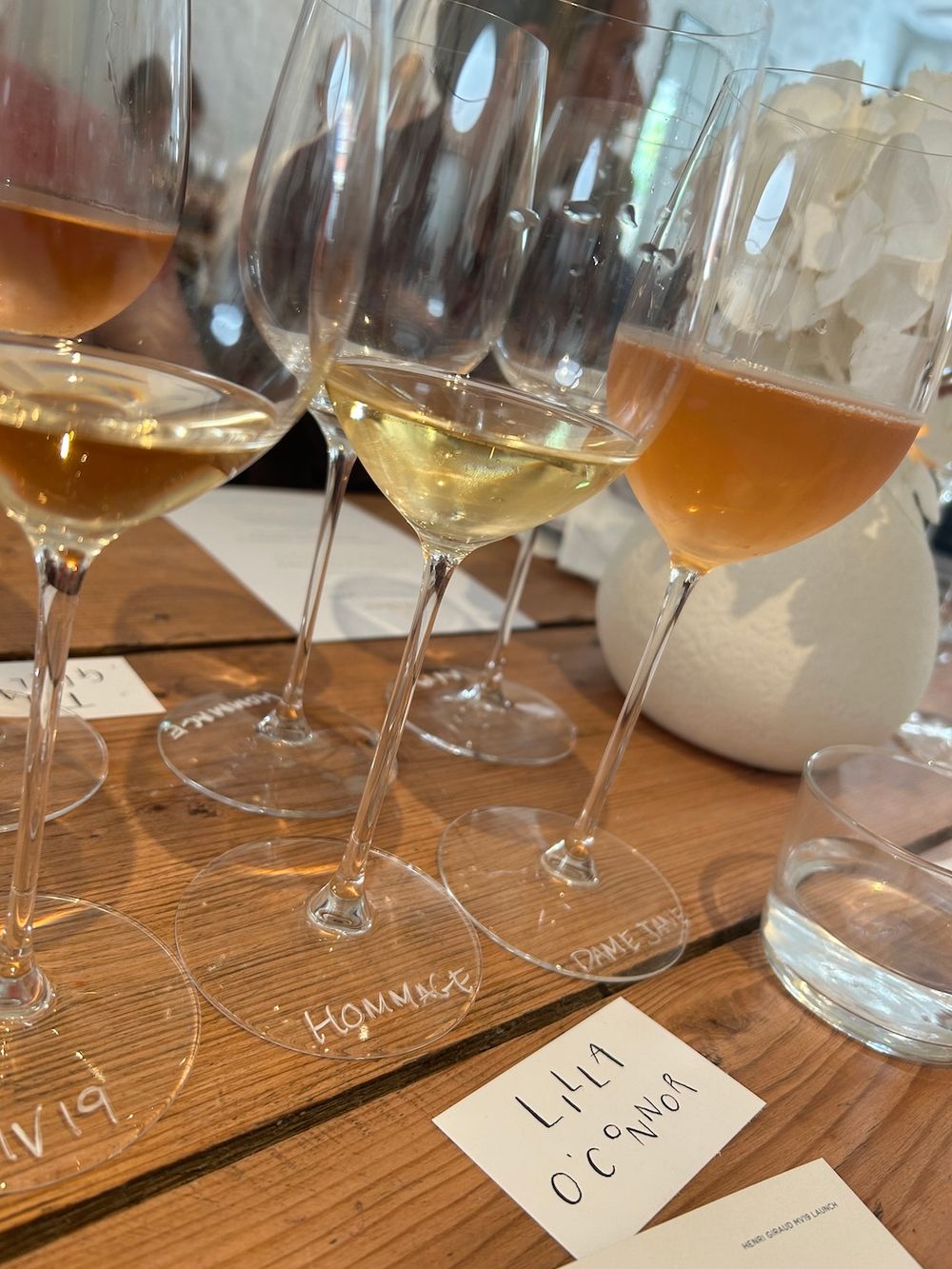My passion for wine grew because it is a product that mirrors its maker. Makers of outstanding wines are charismatic, passionate, hardworking, but most of all, humble. Humble and eager to learn constantly, never acknowledging that they are at the top of their game, eager to accept mistakes and learn more. So let's pause here and admire wine as a living organism, resembling its grape, terroir, vinification techniques, but overall, its maker.
“Don't expect anything, don't force yourself to do anything, make good wine naturally.” – Henri Giraud
The cellar master

“I take on challenges like a mountaineer," Sébastien Le Golvet explaining his winemaking philosophy to Lilla O'Connor
I was seated next to winemaker Sébastien Le Golvet at the launch of Henri Giraud Fut de Chêne MV 2019 Aÿ Grand Cru Brut. Despite the language barrier (my French is worse than Sebastien’s English), first, we drew. He drew a river bed. It felt like playing ‘show-and-‘tell. Sébastien drew a riverbed to explain the intricate process behind Henri Giraud's Champagnes. Drawing quickly became Google Translate and I’ve learnt that each Champagne is produced using wine from its perpetual reserve, created in 1990 and replenished by 20% each year.
“Everything started in 1990,” Sébastien jokes. (At Champagne Henri Giraud, each Champagne blend has its own particular perpetual reserve, all of which were started in 1990.) The wines are stored in concrete tanks housed in underground cellars beneath the Marne River, ensuring a natural and stable temperature of 10˚C year-round, minimising vibrations and preserving the wine's quality and vigour.
Sébastien explains, “The vats are 'embedded' at a depth of 5 metres in the bed of the Marne river. These are concrete vats lined with stainless steel. The advantage is that the wines are 'frozen in time', like statues. The temperature is maintained at 10.5°C all year round, with no need for additional energy.”
Sébastien is as charismatic as his wines, with a deep respect for nature and a passion for sustainability. His approach to winemaking balances tradition with innovation. He meticulously selects oak barrels from the nearby Argonne forest, ensuring that they impart an unique character to Henri Giraud Champagnes without overwhelming them with oak flavours.
Under Sébastien's guidance, the house has reintroduced ancient practices adapted to modern sensibilities, reflecting an holistic approach that emphasises minimal intervention both in the vineyard and the cellar.
The philosopher vigneron

Sébastien Le Golvet: a vigneron has to learn to trust their sensibilities
We learn a lot from winemakers around the world, but often it extends well beyond their vocation. No more so than with Champagne Henri Giraud winemaker Sébastien Le Golvet, whose philosophy as a vigneron extends far beyond the vineyard.
Under the mentorship of his father-in-law Claude Giraud, Sébastien believes a total immersion in one’s surroundings is essential to better understand it. Working with something that is alive, Sébastien believes, requires the nurturing of a symbiotic relationship between himself, his vines, and more broadly with the natural world. “It's not my planet, nor yours, we are nature,” he adds.
Henri Giraud, one of Champagne’s most celebrated producers, takes this immersion philosophy to the extreme, from tasting their own soils to identifying varying terroirs of oak within the Argonne forest that produce the barrels for their barrel-fermented Champagnes. Sébastien guides us through the extraordinary lengths they go to, his determination to reconnect with nature, and learning to trust one’s senses.
When asked about his pragmatic approach, Sébastien says, “When you have a problem, don't pray. Surround yourself with good, caring people so that they can bring out the best in you.”
Inquisitive wine drinkers are eager to extrapolate why doing something in the vineyard or the winery leads to the flavours in the glass. When speaking to a vigneron, it is rare to receive straightforward answers, but as Sébastien explains, it is a succession of small details. In Henri Giraud’s case, a minimum of 10 years of activity and adjustments go into a single glass of Henri Giraud Champagne, as well as a lifetime of experience to help guide decisions throughout the process.
Sébastien compares his winemaking philosophy to climbing a mountain: there are many ways up, and some options are more difficult than others. Some can even lead to a fall, but each time he tackles that mountain, he claims he emerges with a better understanding. He remembers the pitfalls of previous vintages or fermentations that go wrong. He takes inferences that might have led one way and chooses a different direction. Slowly, he finds the right path while remaining humble to the many routes available.
“I take on challenges like a mountaineer: when he's three quarters of the way to the summit, he doesn't choose the easiest route but the most artistic one. Sometimes the North Face is more artistic than the South Face, which seems simpler. A great winemaker shouldn't make a complex wine, but one that conveys emotion. I want a wine that's complex but not complicated to drink.”
The multitude of factors at play in growing grapes and making wine, explains Sébastien, means a vigneron has to learn to trust their sensibilities. His inferences are broad and multifaceted and not necessarily linked to winemaking. He talks about how important childhood memories of picking fresh cherries as a young boy, or the smells of his mother’s cooking, are, all providing him with a memory bank of senses that he refers to today.
The influence of oak

Specific trees are picked for barrels that are then matched with specific plots within the vineyard
There’s still a terroir influence discernible from the oak, insists the House, which has identified 10 terroirs in the Argonne forest. Two key terroirs used for barrel manufacture are Châtrices, which gives sharpness, high acidity, and graphite notes to the wine; and La Chalade, which bestows a rounder, more supple, and generous character. Sébastien identifies and buys the trees he wants to use and has the wood sent to local cooperages to be fashioned into 228-litre barrels.
“The aim of our winemaking,” explains commercial director Stéphane Barlerin, “is the conjunction of the two terroirs: Aÿ (chalk, limestone-based) and Argonne (gaize, sandstone-based).”
A replanting programme ensures that trees are replaced, with plans to replant 30,000 trees every year. The barrels are toasted for a long time at a low temperature and are used for six years on average. The slow growth of oak in the forest, due to limited water, results in tighter-grained trees, translating to less oaky and tighter-structured wines.
Giraud’s barrels come from the Argonne forest around Ste-Ménehould, 80 km (50 miles) east of Aÿ. Claude Giraud's father used the same oak, the traditional source of champagne barrels in the 19th century until fermentation in steel tanks became the norm for the big Houses in the mid-1950s. Claude revived the detailed business of obtaining and certifying oak from the Argonne, involving an established cooper, Camille Gauthier. The barrels, made by tonnellerie Vicard in Cognac, are believed to give a gentler, less aggressive texture and flavour to champagne wines than oak from elsewhere in France.
The craftsmen
One particular skill of Sébastien, seemingly fairly unique in the wine world, is that he toasts his own barrels. Trusting only his sense of smell and how specific toasts will affect different cuvées, Sébastien sources the barrels untoasted and toasts each one. Typically, wine barrels are toasted for 30 to 40 minutes, but he prefers a much lower heat for around 90 minutes — sometimes longer — depending on each barrel and using only his nose to guide him.
When the toasting process starts, he describes the wood smelling of flour, and as it cooks further, the aromas develop to white bread, then darker, wholemeal bread. The bitterness of the green tannins drops out from the barrel, and croissant buttered notes develop. He identifies the character he is looking for, depending on the different vineyard sites, to produce a delicate balancing act between fruit and wood. Even before harvest, he has already decided how he will separate his 200 separate plots of vineyards, identifying which grapes will be fermented in specific barrels.
The extreme sports lover

Le Golvet's motocross passion translates into his adventurous and innovative approach to winemaking.
Sébastien Le Golvet is not just a winemaker; he’s an adventurer at heart, with a passion for extreme sports like motocross. Growing up, Sébastien was deeply influenced by his rural surroundings and developed a love for nature and physical activity.
His motocross passion, which requires precision, balance, and extreme bravery, translates into his adventurous and innovative approach to winemaking. This enthusiasm for balance and thrill is mirrored in his winemaking philosophy.
His connection to the Giraud family runs deep, catching the “passion for winemaking bug” from his father-in-law, Claude Giraud. This familial bond is central to the philosophy at Henri Giraud, where respect for heritage and a drive for innovation coexist harmoniously. Sébastien’s adventurous spirit, combined with his dedication to the craft, ensures that the wines not only express the terroir of Aÿ but also carry a broader environmental consciousness.
The wines tasted

Esprit Nature
Composition: 80% Pinot Noir, 20% Chardonnay, with 1/3 perpetual reserve.
Ageing: 24 months minimum on lees.
Tasting Notes: Fresh and fruity with substantial elegance. Crunchy red apple and lemon peel. Purity and brightness, with the energy of an elite runner, focused and light.
Henri Giraud Aÿ Grand Cru, Fut de Chêne MV 2019
Composition: Majority Pinot Noir, supported by Chardonnay, with 1/3 from the perpetual reserve.
Ageing: Stored in concrete tanks beneath the Marne River.
Tasting Notes: Pale gold. Biscuity, buttery nose with apricots. Almond and a hint of vanilla, a touch of tobacco. Complex, layered palate. Round, creamy, and concentrated with slight tropical notes of mango. Fresh, energetic, well-balanced fruit and minerality with a hint of salt and umami. Rich, creamy, and persistent length.
Hommage au Pinot Noir
Composition: 100% Pinot Noir, with one third reserve wine.
Ageing: 12 months on lees in small barrels, followed by 6 months on fine lees, and 36 months bottle ageing.
Tasting Notes: Peppermint on the nose with brioche. Grapefruit and lime on the finish. Broadens on the palate with butter, open and full. Powerful and dense but with the lightness and elegance of Champagne. Expressive, inviting, and rich.

Dame Jane Rosé
Composition: Base wine of cuvée Hommage, blended with 6% red Pinot Noir and 10% Chardonnay.
Ageing: Matured in sandstone amphora, aged for at least 36 months on lees.
Tasting Notes: Mid salmon colour. Caramelised orange on the nose, biscuits with marmalade and red fruit. Lively bubbles, rosehip, and aniseed. Rich, silky, and refreshing with a smooth finish.
Ratafia Solera
Composition: 70% Pinot Noir, 50% Chardonnay, matured in barrels using the solera method (1990-2016).
Tasting Notes: Honey, liquorice, bruised apple, almost fino-like nose with sweetness. Ripe red apple, marzipan, and almond. Mature and elegant with a soft and smooth finish. “Fortified grape juice, not fortified wine!” says Sébastien. Delicious with crème brûlée
The wines of Champagne Henri Giraud are imported and sold in the UK by New Generation Wines which is a commercial partner of The Buyer.
































